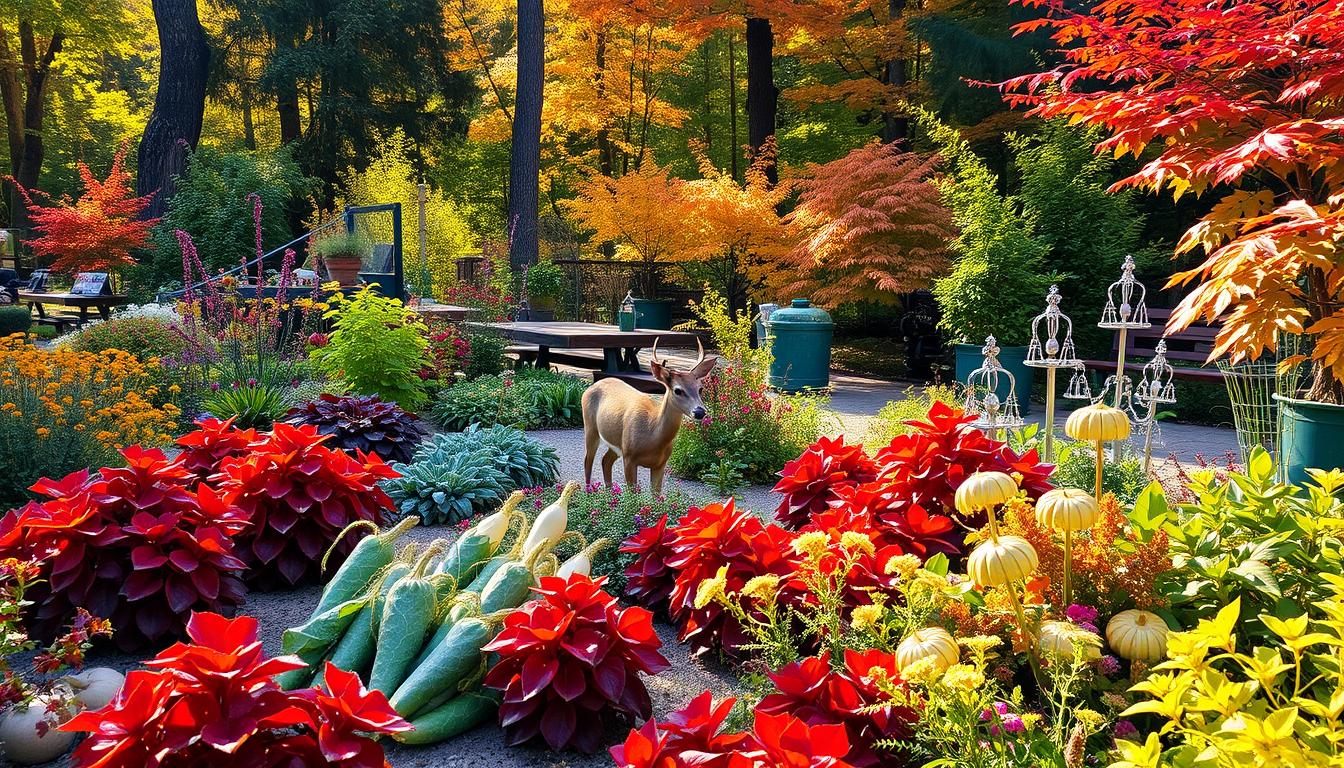Seeing a deer in your garden can be scary for any gardener. Deer eat a lot, up to 6 to 10 pounds every day. What they eat changes based on where they are, the season, and their type.
In spring and summer, deer eat more because they need to grow and feed their young. This is when most people plant their gardens. Deer like many of the same foods we do, except for a few like rhubarb and asparagus.
They especially like beans, lettuce, and broccoli. These are common garden vegetables.
Key Takeaways
- Deer are a common garden pest, consuming 6-10 pounds of food daily.
- Deer prefer many common vegetable crops, such as beans, lettuce, and broccoli.
- Deer activity peaks in spring and summer when food needs are highest.
- Protecting the garden from deer damage is crucial for successful fall and winter gardening.
- Implementing a multi-faceted approach, including physical barriers and deterrents, is essential.
Understanding Deer Behavior and Signs
Deer are fascinating creatures that play a vital role in the ecosystem. However, they can also pose a challenge for gardeners. It’s crucial to understand their behavior and recognize signs of their presence in your garden to protect your plants.
When Deer are Most Active
Deer are most active during the twilight hours of dawn and dusk. This is when they typically feed and move around the most. Unless you’re an early riser or a night owl, you may not see them in your garden during the day. However, you can look for other clues that indicate their presence.
Signs of Deer Activity in Your Garden
- Hoof prints – Deer prints resemble upside-down hearts, and in soft soil, you may see deep, cylindrical holes where their hooves have pressed into the ground.
- Droppings – Look for small, round, pebble-like deer droppings in your garden.
- Trampled plantings – Deer don’t always stick to the designated paths, and their wanderings can leave behind signs of their presence.
- Torn leaves – Deer lack upper front teeth, so when they bite a plant, they jerk their heads and pull, creating a ragged, torn edge on leaves and stems.
By recognizing these signs, you can gain valuable insights into deer activity patterns and feeding habits. This knowledge can help you develop effective strategies to protect your garden.
“Deer consume around 6 to 8 pounds of food a day, making them voracious eaters.”
Physical Barriers to Keep Deer Out
Physical barriers are a top choice for keeping deer away from your garden. You can use deer fencing, electric fencing, double fencing, or even polypropylene fencing or netting. These options help create deer-proof enclosures around your plants.
Fencing Options for Deer Exclusion
Fences under 8 feet might keep some deer away, but others can jump up to 12 feet. To block deer, your fence must be at least 8 feet tall. Electric fencing works too, if it’s charged well and placed near the ground.
Using Netting and Row Covers
- Netting and row covers are great for protecting plants like lettuce and squash. Make sure they’re anchored well to avoid wind damage.
- These physical barriers for deer stop deer from getting to your plants. They keep your garden safe from deer browsing.
- It’s important to follow the right effective fencing heights and fencing installation tips for the best deer exclusion.
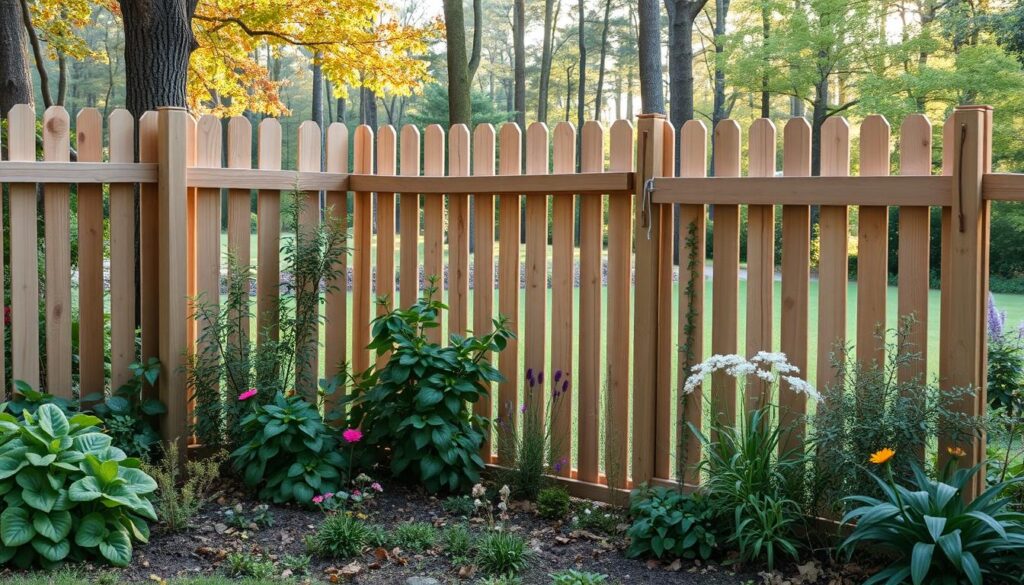
“The only proven, long-term deer exclusion device is the expensive and aesthetically unsatisfying double fence.”
The double fence is the top choice for deer-proof enclosures, even if it’s not the prettiest. Planning and setting up your physical barriers for deer carefully is key to keeping deer out of your garden.
Deer Repellents and Deterrents
Protecting your garden from deer can be done with homemade deer repellents and commercial deer repellents. These natural deer deterrents make the garden an unpleasant place for deer. This keeps them away from your garden.
Popular Deer Repellent Ingredients
Effective deer repellents often use strong smells like hot pepper, garlic, sulfur, and rotten eggs. Studies show that sulfur smells, found in egg products or bloodmeal, are very effective against deer.
Rotating Repellents for Maximum Effectiveness
Experts suggest applying repellents directly to leaves, not just around the garden. Switching between different deer repelling scents keeps deer guessing. This makes your deer repellent effectiveness last longer.
Be careful when using repellents on food plants. Always read the labels to keep your food safe to eat.
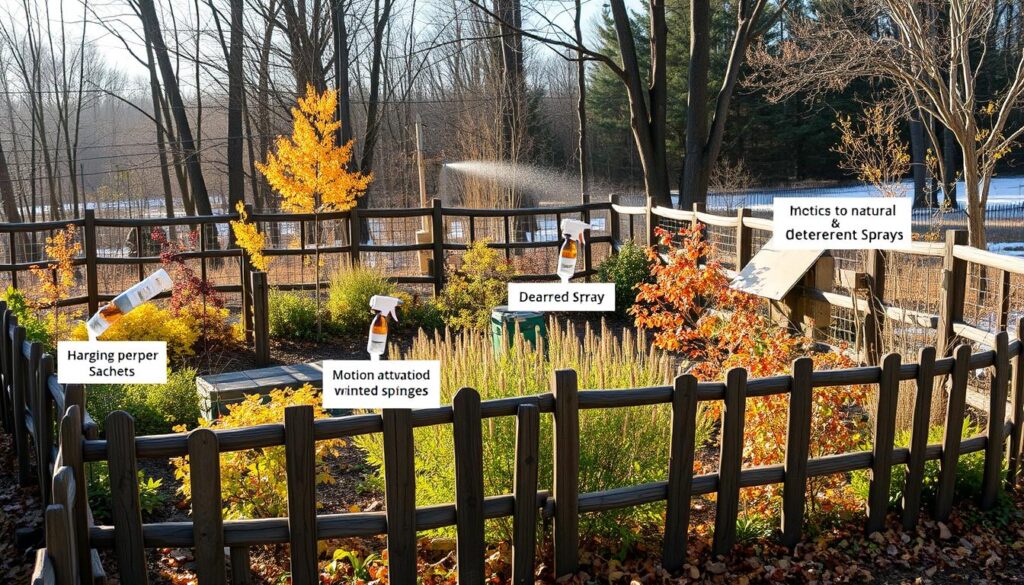
“Consistent applications and rotating repellents are key to getting the best results in deterring deer from your garden.”
Scare Tactics to Frighten Deer Away
Scare tactics can be a good way to keep deer out of your garden. But, deer are smart and can get used to the same scare. To keep deer away, it’s important to change up the scare tactics and their places often.
Devices that squirt water or make loud sounds can scare deer more than still objects. Predator urine also works well because it makes deer think a predator is around.
- Motion-activated deer deterrents can surprise deer with water sprays, lights, or high-frequency sounds.
- Sonic deer deterrents like ultrasonic devices or motion-activated radios can disrupt deer’s sensitive hearing.
- Predator urine deterrents mimic the scent of natural predators, causing deer to avoid the treated area.
Scare tactics work well at first but deer can get used to them. To keep deer away, use different scare tactics and move them around. This keeps deer guessing and scared.
| Scare Tactic | Effectiveness | Drawbacks |
|---|---|---|
| Motion-Activated Deterrents | High | Deer can become accustomed to them over time |
| Sonic Deterrents | Moderate | Deer may adapt to the sounds |
| Predator Urine | High | Requires frequent reapplication |
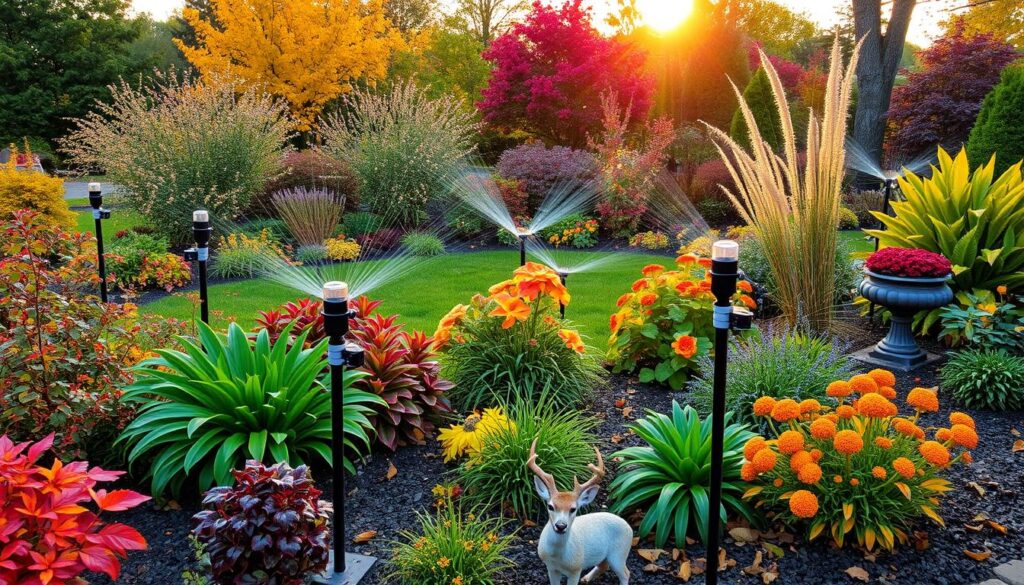
Scare tactics are useful but should be part of a bigger plan to keep deer away. By using different scare tactics and changing them often, you can protect your garden from deer.
Keeping Garden safe from deer in the fall and winter
As the weather gets cooler, deer start to roam more. It’s key to protect your garden from their grazing. Choose plants deer don’t like to keep your garden safe and beautiful this fall and winter.
Choosing Deer-Resistant Plants
Deer have certain plant preferences. Luckily, many plants are deer-resistant. Lavender, giant marigolds, yarrow, and catmint are some examples. You can find the best plants for your garden by checking deer resistance ratings from universities or extension offices.
Companion Planting to Deter Deer
Planting deer-resistant plants with vulnerable ones can also help. These plants’ strong scents can keep deer away. For instance, lavender around roses or clematis vines is both pretty and effective.
By picking deer-resistant plants and using companion planting, you can make a deer-proof garden. With some planning and the right plants, you can enjoy your garden without deer worries.
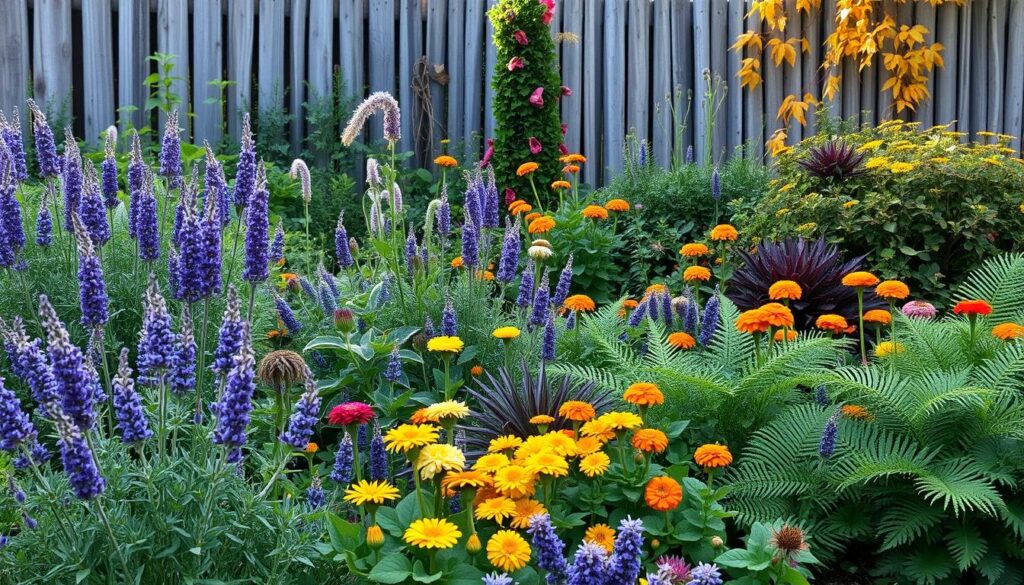
Protecting Trees and Shrubs
As the weather gets colder and food is hard to find, deer may start eating the bark and leaves of your garden plants. This can really hurt or even kill your plants. So, it’s important to protect your trees and shrubs during fall and winter.
Using Tree Guards and Cylinders
One good way to keep your plants safe is with tree guards and cylinders. These barriers go around your plants to stop deer from getting to them. They should be at least six feet tall to protect smaller, younger plants well.
These guards and cylinders are made from wire mesh or plastic. They’re easy to put up and take down. Putting them on in early fall also stops deer from rubbing their antlers on your plants, which can harm them.
Remember, these guards aren’t meant to stay up forever. Take them off in spring when deer damage is less of a worry. This lets your plants grow and thrive without any problems.
By using tree guards and cylinders, you can keep your trees and shrubs safe from deer. This way, your garden will stay healthy and beautiful even in the cold months.
Habitat Modification Techniques
To keep deer out of your garden, make it less appealing to them. Modify the deer habitat around your property. This can help reduce deer visits and damage.
Plant deer-resistant plants near your garden’s edges or where deer like to roam. Lavender, Russian sage, and catmint are good choices. They can keep deer away naturally.
Don’t feed deer in your area. This can make your garden more attractive to them. Also, avoid leaving fallen fruits or veggies. They can draw deer to your garden.
Habitat modification is part of a bigger plan for deer-resistant landscaping. It works best with other methods like barriers, repellents, and scare tactics. Together, they can make your garden less appealing to deer.
| Deer-Resistant Plants | Deer-Attractive Plants |
|---|---|
|
|
Regional Considerations
Protecting your garden from deer requires understanding regional factors. The deer species, local population, and food preferences vary by area. This means different strategies work in different places.
Checking with Local Resources
Always talk to your local Agricultural Extension office or Master Gardener group. They know the best deer management for your area. They can tell you about the regional deer species, local deer behavior, and understanding local deer populations.
Deer management by location is key. What deer don’t like in one place might be their favorite in another. By consulting extension services, you can make sure the plants you choose really work in your area.
Keeping up with local advice helps you create a deer management plan that fits your area. This way, your garden stays safe from deer.
“Deer behavior, population, and preferred food sources can differ significantly by geographic location, so it’s crucial to consult local experts and resources when developing your deer management strategy.”
Combining Multiple Strategies
To keep deer out of your garden this fall and winter, using a mix of methods is best. Combine physical, chemical, and habitat-based deterrents. This creates a strong defense that deer find hard to get past.
Using repellents regularly is a smart move. You can choose from sprays, granules, or concentrates. These contain things like putrescent egg solids, dried blood, or garlic oil. You can also make your own using eggs, hot peppers, soap, and human hair. Switching up the scents and tastes keeps deer guessing.
Don’t forget about physical barriers like fencing and netting. An eight-foot fence is a must since deer can jump over lower ones. Stockade fences and double-layered fencing work well. Invisible deer netting, at least eight feet tall, is also effective. Add colorful strings or streamers to make it stand out to deer.
Changing your garden’s surroundings can also help. Plant deer-resistant plants, use large rocks in borders, and try companion planting. These steps, along with physical and chemical deterrents, can keep deer away from your garden.
| Deer Control Method | Description | Effectiveness |
|---|---|---|
| Fencing | An 8-foot-tall fence, stockade or double-layered, to physically exclude deer | High |
| Deer Repellents | Commercial and homemade sprays, granules, or concentrates with scents/tastes deer dislike | Moderate to High (when rotated) |
| Habitat Modification | Planting deer-resistant species, creating wide borders, and using companion planting | Moderate to High |
By mixing these deer control methods and keeping up with them, you can build a strong defense. This makes your garden less inviting to deer during the fall and winter.
Conclusion
To keep deer out of your garden, you need a mix of methods. This includes using physical barriers, chemical repellents, scare tactics, and changing your garden’s layout. Knowing how deer behave and spotting their signs helps a lot. This way, you can protect your plants and enjoy a good harvest, even when it gets colder.
Always keep an eye out and change your strategies often. Also, check with local experts to find the best deer control plan for your area. With the right steps, your garden can stay healthy and deer-free all year. The secret is to be proactive and use a variety of methods to keep your garden safe.
This article has given you the tools to fight off deer in your garden. You can use physical barriers, repellents, or choose plants that deer don’t like. The actions you take now will help your garden for a long time. Stay alert, think outside the box, and use a mix of methods to keep your garden safe and in balance with the local deer.


